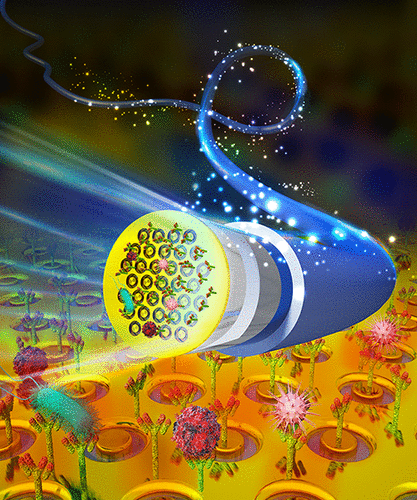Our official English website, www.x-mol.net, welcomes your feedback! (Note: you will need to create a separate account there.)
Subradiant Dipolar Interactions in Plasmonic Nanoring Resonator Array for Integrated Label-Free Biosensing
ACS Sensors ( IF 8.9 ) Pub Date : 2017-12-04 00:00:00 , DOI: 10.1021/acssensors.7b00607 Yuzhang Liang 1 , Hui Zhang 1 , Wenqi Zhu 2, 3 , Amit Agrawal 2, 3 , Henri Lezec 2 , Lixia Li 4 , Wei Peng 4 , Yi Zou 1 , Yanqing Lu 1 , Ting Xu 1
ACS Sensors ( IF 8.9 ) Pub Date : 2017-12-04 00:00:00 , DOI: 10.1021/acssensors.7b00607 Yuzhang Liang 1 , Hui Zhang 1 , Wenqi Zhu 2, 3 , Amit Agrawal 2, 3 , Henri Lezec 2 , Lixia Li 4 , Wei Peng 4 , Yi Zou 1 , Yanqing Lu 1 , Ting Xu 1
Affiliation

|
With the development of advanced nanofabrication technologies over the past decade, plasmonic nanostructures have attracted wide attention for their potential in label-free biosensing applications. However, the sensing performance of nanostructured plasmonic sensors is primarily limited by the broad-line-width features with low peak-to-dip signal ratio in the extinction spectra that result from strong radiative damping. Here, we propose and systematically investigate the in-plane and out-of-plane dipolar interactions in an array of plasmonic nanoring resonators that are from the spatial combination of classic nanohole and nanodisk structures. Originating from the strong coupling of the dipolar modes from parent nanohole and nanodisk structures, the subradiant lattice plasmon resonance in the nanoring resonator array exhibits narrow-line width spectral features with high peak-to-dip signal ratio and strong near-field electromagnetic enhancement, making it an ideal platform for high-sensitivity chemical and biomedical sensing. We experimentally demonstrate that the plasmonic nanoring resonator array can be used for high-sensitivity refractive index sensing and real-time monitoring of biomolecular specific binding interactions at nanomolar concentration. Moreover, due to its simple normal incident illumination scheme and polarization independent optical response, we further transfer the plasmonic nanoring resonator array onto the optical fiber tip to demonstrate an integrated and miniaturized platform for label-free remote biosensing, which implies that the plasmonic nanoring resonator array may be a potential candidate for developing high performance and highly integrated photonic biosensing systems.
中文翻译:

等离子体纳米环谐振器阵列中的亚辐射偶极相互作用,用于集成的无标记生物传感。
在过去的十年中,随着先进纳米加工技术的发展,等离激元纳米结构因其在无标签生物传感应用中的潜力而受到广泛关注。但是,纳米结构的等离激元传感器的感测性能主要受宽线宽特征的限制,这些特征是由于强烈的辐射衰减而导致的消光光谱中的峰-峰信号比低。在这里,我们提出并系统地研究了等离子纳米环共振器阵列中的平面内和平面外偶极相互作用,这些相互作用来自经典的纳米孔和纳米盘结构的空间组合。源自母纳米孔和纳米盘结构的偶极模式的强耦合,纳米环共振器阵列中的亚辐射晶格等离子体激元共振具有窄线宽频谱特征,具有高峰峰比信号比和强大的近场电磁增强特性,使其成为高灵敏度化学和生物医学传感的理想平台。我们实验证明,等离激元纳米环共振器阵列可用于高灵敏度折射率感测和实时监测纳摩尔浓度的生物分子特异性结合相互作用。此外,由于其简单的法向入射照明方案和偏振无关的光学响应,我们将等离激元纳米环谐振器阵列进一步转移到了光纤尖端上,以展示用于无标签远程生物传感的集成化和小型化平台,
更新日期:2017-12-04
中文翻译:

等离子体纳米环谐振器阵列中的亚辐射偶极相互作用,用于集成的无标记生物传感。
在过去的十年中,随着先进纳米加工技术的发展,等离激元纳米结构因其在无标签生物传感应用中的潜力而受到广泛关注。但是,纳米结构的等离激元传感器的感测性能主要受宽线宽特征的限制,这些特征是由于强烈的辐射衰减而导致的消光光谱中的峰-峰信号比低。在这里,我们提出并系统地研究了等离子纳米环共振器阵列中的平面内和平面外偶极相互作用,这些相互作用来自经典的纳米孔和纳米盘结构的空间组合。源自母纳米孔和纳米盘结构的偶极模式的强耦合,纳米环共振器阵列中的亚辐射晶格等离子体激元共振具有窄线宽频谱特征,具有高峰峰比信号比和强大的近场电磁增强特性,使其成为高灵敏度化学和生物医学传感的理想平台。我们实验证明,等离激元纳米环共振器阵列可用于高灵敏度折射率感测和实时监测纳摩尔浓度的生物分子特异性结合相互作用。此外,由于其简单的法向入射照明方案和偏振无关的光学响应,我们将等离激元纳米环谐振器阵列进一步转移到了光纤尖端上,以展示用于无标签远程生物传感的集成化和小型化平台,


























 京公网安备 11010802027423号
京公网安备 11010802027423号